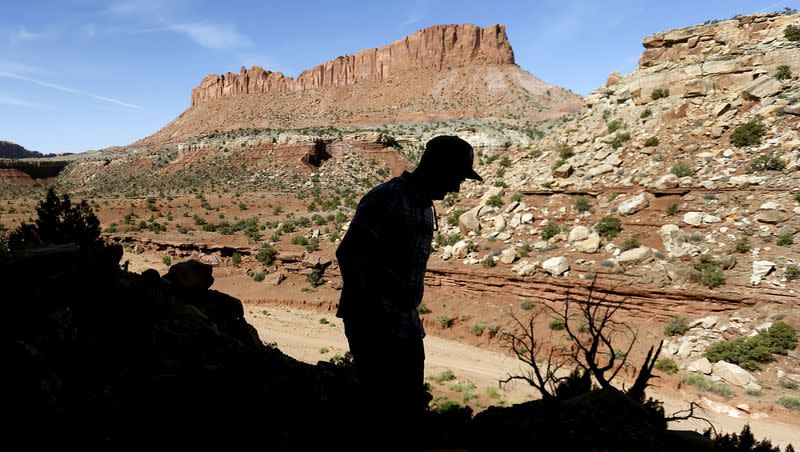A proposed national monument in Arizona impacts Utah ranchers, energy

- Oops!Something went wrong.Please try again later.
A possible 1.1 million-acre monument designation in northern Arizona is being sought by Native American tribes and conservation organizations, but it has potential to impact a significant number of Utah ranchers who can only access winter range within its boundaries.
And mining uranium — which is critical for a carbon free future according to the Biden push for next generation nuclear technology — would be off limits.
The proposed Baaj Nwaavjo I’tah Kukveni Grand Canyon National Monument is only in Arizona, bordering the nearby Grand Staircase-Escalante National Monument in the Kane County area but also encompassing lands south of Washington County, potentially impacting Hildale, which straddles the border of Arizona and Utah.
A listening meeting by the Bureau of Land Management and U.S. Forest Service was held Tuesday in Flagstaff, where the Utah Farm Bureau officially submitted comments voicing its opposition.
“Although the national monument is located within the boundaries of Arizona, portions of the national monument will disproportionately affect ranchers in southern Utah by including a remote region of the state known as the Arizona Strip,” wrote Ron Gibson, president of the Utah Farm Bureau. “The Arizona Strip is geographically separated from the rest of Arizona, is sparsely populated and is culturally tied to Utah.”
Gibson pointed out that many ranchers in Kane and Washington counties graze their cattle at higher altitudes in southern Utah and later winter in the lower elevations found on the Arizona Strip.
“We are concerned that the proposed national monument will eliminate this vital winter range either by prohibiting grazing outright or by placing new, unnecessary restrictions on grazing permits that will render them economically unviable.”
In April, the Grand Canyon Tribal Coalition implored the Biden administration to protect the greater Grand Canyon area given its cultural and historical significance to at least 12 Native American tribes or nations. The group wants the designation to protect cultural and religious heritage and native environments — and to protect it from mining.
The coalition includes the Havasupai, Hopi, Hualapai, Kaibab Paiute, Moapa Paiute, Las Vegas Paiutes, Paiute Tribe of Utah, the Navajo Nation, the San Juan Southern Paiute Tribe, the Yavapai-Apache Nation, the Pueblo Tribe of Zuni and the Colorado River Indian Tribes. The monument designation has the support of Rep. Raul Grijalva, D-Tucson, and Sen. Kyrsten Sinema, a former Democrat who is now an independent from Arizona.
Katie Hobbs, Arizona’s Democratic governor, also wrote to Biden in May to urge the monument designation.
The designation, which would happen by Biden’s use of the 1906 Antiquities Act, is also touted by supporters as a way to lock up uranium deposits, which could be as much as 375 million pounds used to fuel the deployment of nuclear energy by the United States. The U.S. currently gets the bulk of its uranium from foreign countries, including Russia and China.
Related
A 20-year ban on uranium mining near the Grand Canyon was put in place in 2012 by the Obama administration, but it has been subject to court challenges and political scrutiny.
Related
According to the Kingman, Arizona, newspaper The Miner, Mohave County officials have said the region contains the highest-grade uranium endowment in the United States, and a full third of all known uranium deposits in the country.
Washington and Kane counties are opposed to the monument designation, as is the community of Hildale.
At a June meeting of Utah’s Federalism Commission, state Rep. Carl Albrecht, R-Richfield, expressed concerns about the proposed monument designation because of its impact on farmers and uranium mining.
“This proposed monument would pretty much leave us high and dry for our uranium supply. If we are going to go nuclear with zero carbon, we cannot go buy fuel from Russia, our enemies. We need to be very much aware of what this administration is trying to do when it comes to carbon and power generation and when it comes to grazing.”
At the same meeting, Redge Johnson, director of the Utah Public Lands Policy Coordinating Office, said the proposal has significant implications for Utah, although the monument would be entirely in Arizona.
“Normally we would not be involved with another state’s efforts on a monument, but where that one section of the monument, this northwest section, really does impact mostly people from the state of Utah, the governor’s office has given us a nod to write some comments on that section,” he said. “It is a little frustrating right now in D.C. because we do wonder sometimes if the right hand is talking to the left hand when it comes to federal designations and tying up these minerals, whether it be critical minerals or uranium.”
For the Utah Farm Bureau, the fear is the potential impact on ranchers if the designation is exclusionary to those rights.
“Public lands grazing and the ranching way of life also provide many important cultural contributions. The agriculture community in southern Utah and the Arizona Strip is central to the region’s identity and sense of community,” Gibson said in his comments.
“Ranching instills a sense of hard work, responsibility, and stewardship of the land. Ranchers care deeply for the public lands that they utilize. Limiting or removing livestock grazing from federal lands in this area will fundamentally alter the culture, heritage, and values of the region.”
Gibson said farm bureau members also object to the lack of government meetings in Utah on the proposed designation.
A Utah Farm Bureau representative from the Garfield County area had to attend the meeting in person since there was a lack of any live streaming.

